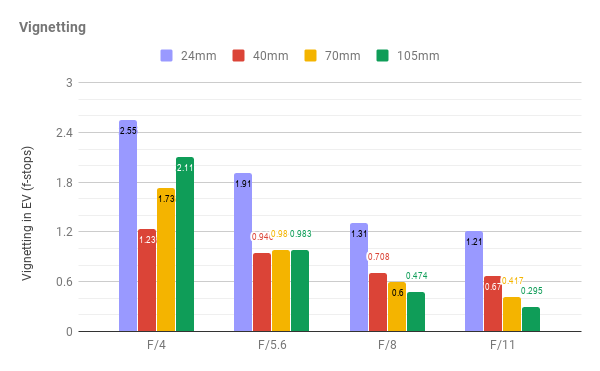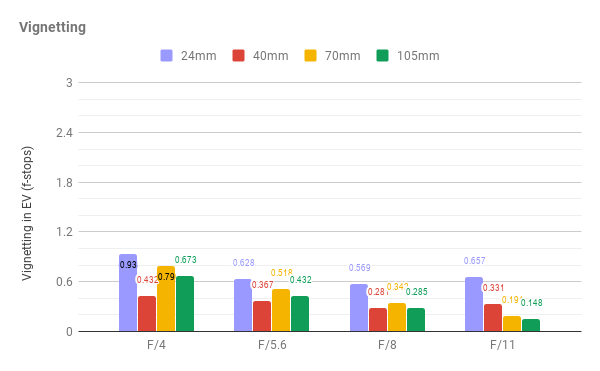|
Canon RF 24-105mm f/4 USM L IS - Review / Test Report - Analysis |
|
Lens Reviews -
Canon EOS (Full Format)
|
|
Page 2 of 3

Distortion
Most mirrorless camera manufacturers (Hello Sony, Panasonic, Olympus, Fuji) rely on image auto-correction thus, they are under-designing their lenses. To some degree, this can make sense if minimizing size/weight is the goal (or profits ...). This is only our 2nd RF lens review, but so far, it seems as if Canon does not share this philosophy - which is a good thing in our book. The Canon RF 24-105mm f/4 USM L IS does have its share of image distortions, but they aren't quite as extreme as what we've seen elsewhere. At 24mm there is, of course, a fairly heavy degree (3.3%) of barrel distortion, but it's still within acceptable limits. At the other focal lengths that we tested, there are slight to medium pincushion distortions. If this is too much, you can, of course, still activate image auto-correction to handle these issues.
Vignetting
The vignetting characteristic is a bit higher than on the (DSLR-centric) EF 24-105mm f/4 USM L IS II, but it's not excessive, and it's much better than on the Sony FE 24-105mm f/4 G OSS. At 24mm & 105mm @ f/4, you will have to live with a heavy light-falloff of 2.6EV (f-stops) and 2.1EV, respectively. It's a bit less in the middle range at this aperture. Stopping down to f/5.6 helps a lot in the medium to upper focal length range. At 24mm, you may wish to stop down to f/8 if needed.
 If you don't want to care and activate auto-correction, the issue will be eased quite a bit, of course. The vignetting will stay below 1 EV (f-stop) even at 24mm f/4 - at cost of increased corner noise due to signal amplification.
If you don't want to care and activate auto-correction, the issue will be eased quite a bit, of course. The vignetting will stay below 1 EV (f-stop) even at 24mm f/4 - at cost of increased corner noise due to signal amplification.

MTF (resolution)
The Canon RF 24-105mm f/4 USM L IS does a very good job when it comes to image resolution. The sweet spot is at 24mm, where it is capable of producing a very sharp image across the entire image frame, and that's straight from f/4. There is not much in it by stopping down to f/5.6 (other than increasing the depth-of-field, of course). There's a marginal loss in corner quality at the 40mm and 70mm settings, but the quality is still very good. The 105mm setting shows a more pronounced drop in border/corner quality at f/4, but it's not too bad (=good). It is, however, impressive that the broader center zone remains tack sharp - typically, there's a loss in quality at this setting. Stopping down to f/5.6 lifts the border resolution, but for the best results, you should stick to f/8. A noticeable drop in quality due to diffraction starts to kick in at f/11, but even f/16 remains usable - at least on the 30mp sensor of the EOS R (diffraction effects would be more obvious on higher megapixel sensors).
The centering quality of the tested sample was Okayish, with an irregularity on the right side. The field curvature is comparatively low.
Please note that the MTF results are not directly comparable across the different systems!
Below is a simplified summary of the formal findings. The chart shows line widths per picture height (LW/PH) which can be taken as a measure of sharpness.
If you want to know more about the MTF50 figures, you may check out the corresponding Imatest Explanations
Chromatic Aberrations (CAs)
Modern, professional-grade lenses tend to have very low CAs. Unfortunately, this isn't quite true for the RF 24-105mm f/4 USM L IS. While not terrible, CAs can be clearly visible (unless you correct them, of course). That's especially true for the wide-end of the zoom range, where the averaged CA pixel width can exceed 2px at the image borders (and more so in the corners). Stopping down reduces the issue to some degree.
 Just to give you an idea - below is a crop taken from a lab image at 24mm f/4.
Just to give you an idea - below is a crop taken from a lab image at 24mm f/4.

Bokeh
Let's be honest - you won't (shouldn't) buy this lens for its shallow depth-of-field capabilities - a max. aperture of f/4 is just not ideal for this purpose. However, if you chose a fairly close focus distance, it's not an alien concept for this lens either.
One of the typical shortcomings of standard zoom lenses is a somewhat busy rendering of out-of-focus highlights. That also applies to the Canon lens as you can see below. The highlight discs may be circular thanks to 9 aperture blades, but the inner zone of the discs is somewhat busy (onion-style) - probably a side effect of the 3 aspherical elements in the design. The discs deteriorate to cat eyes towards the corners (as usual).
 When looking at the general quality of the blur in the focus transition zone, the quality of the bokeh isn't overly brilliant. The background blur is fairly smooth but not really symmetrical and somewhat smeared. The foreground blur is rather rough with distinctive double-lined edges (Nisen bokeh).
When looking at the general quality of the blur in the focus transition zone, the quality of the bokeh isn't overly brilliant. The background blur is fairly smooth but not really symmetrical and somewhat smeared. The foreground blur is rather rough with distinctive double-lined edges (Nisen bokeh).

|